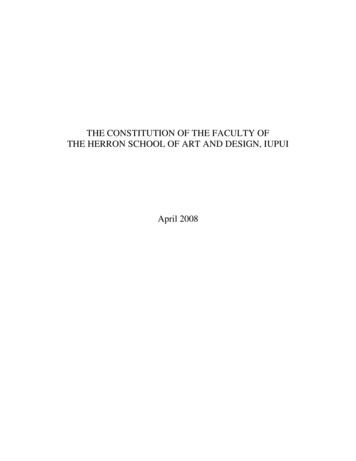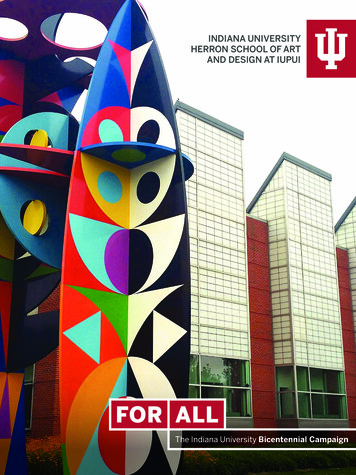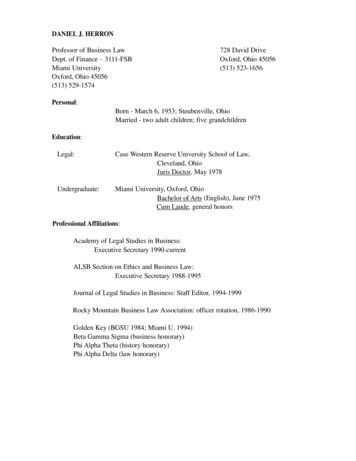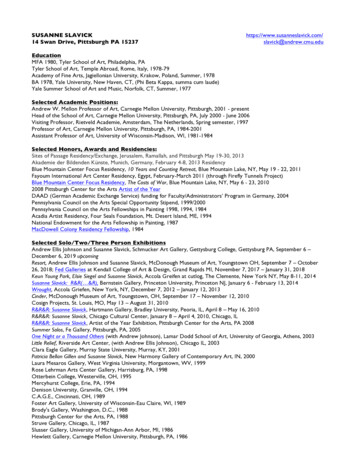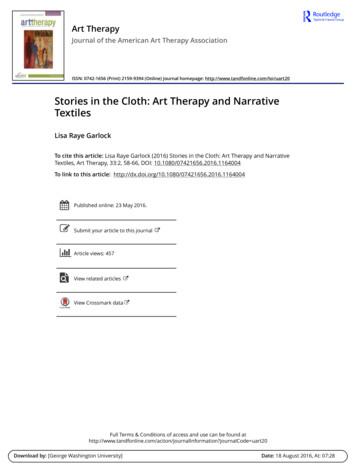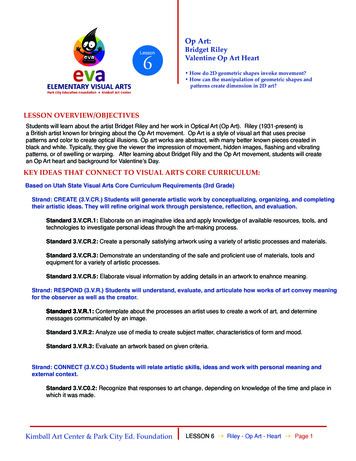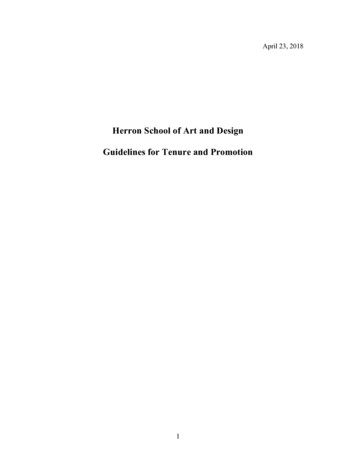
Transcription
April 23, 2018Herron School of Art and DesignGuidelines for Tenure and Promotion1
Guidelines for Faculty Tenure and PromotionsHerron School of Art and Design / IUPUIContentsI N T RO D U C T I O N . 3TIME IN RANK . 3A. CRITERIA FOR THIRD-YEAR REVIEW OF TENURE-TRACK FACULTY . 4B. THIRD-YEAR REVIEW TIMELINE . 4TIME TABLE FOR THIRD-YEAR REVIEW OF FACULTY . 4C. TENURE . 5D. PROMOTION . 51. Recommended Time in Rank . 52. Nomination for Full Professor. 5II. DOSSIER PREPARATION FOR TENURE AND PROMOTION . 5A. CANDIDATE . 5B. ADDITIONAL SUPPORT MATERIALS . 6C. TIME TABLE FOR INITIATING AND PROCESSING TENURE AND PROMOTION . 6III. AREAS OF REVIEW . 8A. TEACHING . 8B. RESEARCH / CREATIVE ACTIVITY . 10C. SERVICE . 13IV. AREA OF EXCELLENCE. 15A. ASSOCIATE PROFESSOR . 15B. PROFESSOR . 15V. OVERLAPPING AREAS OF REVIEW . 16A. Civic Engagement . 16VI. SATISFACTORY / UNSATISFACTORY PERFORMANCE . 16A. TEACHING . 16B. RESEARCH/CREATIVE ACTIVITY . 17C. SERVICE . 17APPENDICES . 18APPENDIX A . Error! Bookmark not defined.APPENDIX B . 24APPENDIX C . 28APPENDIX D . 29APPENDIX E . 312
Guidelines for Faculty Tenure and PromotionsHerron School of Art and Design / IUPUII N T RO D U C T I O NEvery Herron faculty member has a Department Chair or Program Director, whose responsibilities includeproviding guidance concerning professional matters, encompassing career development with a view towardthe promotion and tenure process. Each new faculty member will be assigned a faculty mentor to helpguide them through this process. Additional consultation with senior colleagues is strongly recommended.On initial hiring, each full-time tenure-track and non-tenure track faculty member is given access to theHerron School of Art and Design Guidelines for Faculty Tenure and Promotion and IUPUI Office ofAcademic Affairs Guidelines for Preparing and Reviewing Promotion and Tenure Dossiers. The IUPUIGuidelines for Preparing and Reviewing Promotion and Tenure Dossiers are updated annually andcandidates for promotion and/or tenure should review the guidelines on an ongoing basis. All candidatesare strongly advised to attend relevant campus and unit workshops towards promotion and/tenure. Theformal promotion and tenure process begins when the tenure track faculty member is hired.Herron faculty in their probationary period are required to participate in a comprehensive review duringtheir third year. This review is distinct from the annual reviews required for all faculties (tenured and nontenured). In the third-year, a workshop designed to assist candidates in preparing for this review is held inNovember. Faculty who are in their fifth year and who will be evaluated for promotion and/or tenure thefollowing year are also invited to attend the November workshop. Participants are again given all relevantdocuments, are provided access to exemplary dossiers, and are party to workshop discussions concerningschool expectations, dossier preparation, and the essential documentation for a successful review.The Three-Year review is similar to the promotion and/or tenure review with the exception that evaluationby external reviewers to the university is not required. Third-Year Faculty prepare a complete tenure andpromotion dossier which is similar in substance and format to that which they will submit for the actualreview two years later. Candidates must request peer observation of classroom teaching, and provide coursematerials and syllabi. All compiled materials should be included in the dossier and forwarded to the HerronUnit Tenure and Promotion Committee for review. The Herron Unit Tenure Promotion Committee willprovide an extensive written evaluation and consultation to the candidate.A spring workshop reviewing the tenure and promotion process, including any new campus guidelines andregulations, is held annually. The spring workshop is open to any Herron full-time faculty member.Following submission of the tenure and promotion dossier at the end of the fifth year, no further formalguidance or assistance is given until a faculty member may be considered for further promotion in rank(generally, but not always, to the rank of full professor). Annual reviews continue and typically addressissues of progress in rank. Promotion and tenure candidates are informed of decisions made at each step inthe process.TIME IN RANKIn most instances, the work being assessed as the basis for tenure and/or promotion will have beencompleted since initial appointment or the last promotion. While the probationary period for untenuredfaculty ordinarily is six years, special conditions may warrant earlier than normal consideration.3
A. CRITERIA FOR THREE-YEAR REVIEW OF PROBATIONARY FACULTYThe Herron Tenure and Promotion Committee monitors the progress of all probationary faculty during theirthird year of employment, reviewing documentation of progress in the areas of Teaching, Service, andResearch/Creative Activity.The Herron Tenure and Promotion Committee will conduct a Three-Year Review in the springof the third year of employment of tenure-track faculty, lecturers and clinical rank. This process, which isrequired by the campus for tenure-probationary faculty, ensures that all probationary faculty benefit from ahelpful and meaningful assessment of their progress towards promotion and tenure near the midpoint oftheir probationary period.Candidates being reviewed should submit a Candidate’s Statement, together with a current CurriculumVitae (in accordance with the “IUPUI Guidelines for Preparing and Reviewing Promotion and TenureDossiers”). The Candidate’s Statement (not to exceed five pages) should be similar in organization to thestatement expected at the time of making a case for promotion and tenure. The Candidate’s Statementshould identify the anticipated area(s) of excellence or the intention to request consideration of a balancedcase.Candidates should also include ongoing faculty peer review of teaching, and a global summary of studentevaluations. Candidates should look at the “Three-Year Review Dossier Checklist for Candidates”(Appendix C) to see the complete list of what they should include in the Third-Year Dossier. All materialsshould be submitted in electronic format as searchable pdfs.B. THREE-YEAR REVIEW TIMELINEThe Three-Year Review will take place in the spring semester of the third year of employment for tenureprobationary faculty, lecturers and clinical rank or sooner if a faculty member was granted credit towardtenure upon employment by Indiana University.TIME TABLE FOR THIRD-YEAR REVIEW OF FACULTYBy the Second Week of Fall SemesterThe Herron Human Relations Specialist notifies all tenure-track faculty, lecturers, and clinical facultyentering their third year in rank that they will be undergoing a Three-Year Review during the upcomingacademic year. The HR Specialist will copy the Herron Unit Tenure and Promotion Committee (HUTPC)Chair that candidates have been notified.November of the Third YearMembers of the Herron Unit Tenure and Promotion Committee (HUTPC) conduct a workshop for ThreeYear candidates. (Candidates who will be submitting dossiers for tenure and promotion at the end of theacademic year may also attend this workshop.)The First Friday following the start of Spring SemesterThe candidate provides the HUTPC Chair with an electronic copy in a searchable pdf format of a dossierthat includes all required components noted in Appendix C.By the End of JanuaryThe HUTPC Chair informs the candidate if any dossier contents are incomplete or need revision.The Second Monday in FebruaryThe candidate provides the HUTPC Chair with two electronic copies of the final version of the dossier,with any revisions. This version should include an Appendix with copies of all student evaluationsconducted in all classes while in rank.4
No Later than February 15The HUTPC Chair submits the dossier to the Department Chair or Program Director for review.March 1The Department Chair or Program Director submits evaluation to the HUTPC Chair, who adds theevaluation to the dossier.Before the End of MarchThe Herron Unit Committee completes its deliberation, votes on each candidate and submits evaluationwith the dossier to the Dean.Before April 15The Dean of the Herron School of Art and Design prepares an evaluation of the candidate’s dossier. Fortenure-track faculty, the Herron Human Resources Specialist sends a copy of the dossier and the Dean’srecommendation to the Dean of Faculties, IUPUI, notifying the HUTPC Chair that the dossier andrecommendation have been sent forward.C. TENUREThe standard probationary period for tenure-track faculty is seven years with the sixth year being the yearof review. This means that a dossier must be prepared after five years on the tenure track. This dossierpasses through various levels of review during the fall and spring of the sixth year with the notice of tenureor non-tenure being given to the faculty member near the close of that academic year. One may requestreview for tenure before the end of the probationary period. However, it is recommended that one take thefull probationary period to prepare as strong a case for tenure as possible.D. PROMOTION1. Recommended Time in RankThere are no rigid time periods specifying the length of time a faculty member must serve in a particularrank before seeking promotion. The HUTPC urges most faculty to seek promotion to the rank of associateprofessor at the same time that review for tenure takes place. Promotion to this rank may be sought earlierin the probationary period if the faculty member believes that his/her performance is strong enough to gainpromotion. There is no expected period between associate and full rank, although most associate professorsseek full rank five to ten years after promotion to associate rank.2. Nomination for Full ProfessorAn individual may initiate his/her own promotion or may be nominated by a senior faculty member,Program Director, Department Chair or the Dean. A faculty member seeking promotion to Full Professormust submit to the Dean of Herron the “Candidacy for Promotion in Academic Rank” form (Appendix E)and a current Curriculum vitae by February 15 if they wish to submit a dossier at the end of that samesemester.II. DOSSIER PREPARATION FOR TENURE AND PROMOTIONA. CANDIDATE5
1. Read all pertinent materials (IU Academic Handbook, IUPUI Guidelines for Preparation of Tenure andPromotion Dossiers, and Herron Tenure and Promotion Guidelines).2. Consult with Department Chair, Program Director, Herron Unit Tenure Promotion Committee, facultymentor, and senior faculty.3. Begin collecting material for dossiers starting with initial appointment.4. Begin to identify an area of excellence early in the academic appointment. (See the IU AcademicHandbook for more information regarding the balanced case.)5. Attend faculty development workshops that deal with tenure and promotion issues.B. ADDITIONAL SUPPORT MATERIALSThere are several components of a dossier that require outside support.1. Annual Reviews of tenure-probationary faculty must be done regularly and conscientiously. The Dean,Department Chair, and Program Director all play a part in this process.2. Department Chairs or Program Director provide annual reviews for all faculty, and candidates forpromotion or tenure should request and expect written statements.3. Formal student evaluations of faculty must be conducted in a regular and comprehensive fashion. Thisfunction is administered and correlated by the Office of the Dean. However, individual faculty members areresponsible for making sure evaluations are distributed and completed by a high percentage of studentsenrolled in each class. No faculty member should be present while students are completing evaluations.4. Peer review of classroom teaching is required and should be initiated regularly before the three-year reviewand again before the tenure and/or promotion review in the sixth year.5. External letters of recommendation should be obtained with the aid of the Department Chair, ProgramDirector and the Chair of the Unit Committee. The candidate and Chair or Director formulate the list ofoutside references, and the Chair of the Unit Committee sends a form letter to everyone on the list requestingthe reference. Letters must be from individuals not personally associated with the candidate since such lettersare viewed as being a more objective evaluation of work not influenced by bias for or against the candidate asa person. The candidate's curriculum vitae and documentation of research/creative activities is sent with thisrequest. All letters formally requested and received must become a part of the dossier.C. TIME TABLE FOR INITIATING AND PROCESSING TENURE AND PROMOTIONAugust*The HR Specialist provides the Herron Unit Tenure and Promotion Committee Chair with the names of allcandidates who will be submitting a dossier either for a Third-Year Review or for a final tenure andpromotion review within the next year.*This refers to one year prior to submission of final dossier for tenure and promotion.OctoberThe HUTPC and HR Specialist provide a workshop for faculty who will be submitting a dossier for aThird-Year Review and/or for evaluation for promotion and/or tenure during the following year.February 15Any faculty member wishing to be considered for promotion from associate to full professor, or fromlecturer to senior lecturer during the following academic year should provide to the Dean the “Candidacy6
for Promotion in Academic Rank” form and a current Curriculum Vitae. On the form the candidate shoulddeclare the area (or areas) in which excellence will be claimed, including the possibility of a balanced casedesignation.Before March 30The candidate for tenure and promotion may provide: 1) a list of anyone they definitely would not want toserve as external reviewers; 2) a list of expert scholars in the field who meet the “arm’s length” orindependent reviewer criteria for external reviewers as described in the IUPUI Guidelines. Chairs are notrequired to use the external reviewers suggested by the candidatesAprilThe HUTPC and HR Specialist provide a workshop for any faculty who wish to learn more about thepromotion and/or tenure process.Before April 15The candidate’s Department Chair or Director will develop a final list of approximately eight externalreviewers, and submit the list to the HUTPC Chair and HR Specialist. (At least six external assessmentletters are required in the final dossier.)Before April 30Inquiry sent by HUTPC Chair or HR Specialist to external reviewers asking availability to conduct areview of the candidate’s work.The first Friday in MayThe candidate submits a copy of their initial dossier and sample documents in electronic pdf format to theHR Specialist. The HR Specialist provides a copy to the HUTPC Chair.Before May 15The HUTPC Chair reviews the dossier to make sure all required components are included. If elements aremissing, the candidate should provide those elements before May 31The HUTPC Chair or HR Specialist solicits external letters of review.Last Friday in JulyAll External Letters of Evaluation are received by the HR Specialist.By August 1stThe candidate for promotion and/or tenure should upload /submit final dossier with required documents(as specified in the IUPUI Guidelines for Tenure and Promotion Checklist) . The HR Specialist insertsletters into the dossier and provides the HUTPC Chair access.By August 15thThe HUTPC Chair reviews the dossier to make sure all required components are included.The HUTPC Chair submits dossier, releasing it for review by the Department Chair or Director.By September 1The Department Chair or Director submits recommendation and other materials, releasing them to theHUTPC Committee for their review.By September 20The Herron Unit Tenure Promotion Committee completes its deliberation and votes on each candidate.By October 1The HUTPC Chair inserts the committee’s recommendation into the dossier and submits the dossier to theDean.By October 20The Dean’s recommendation is inserted into the dossier and submitted to the HR Specialist.7
By the last Friday in OctoberThe HUTPC Specialist forwards the dossier of the candidate to the Dean of Faculties, IUPUI.III. AREAS OF REVIEWA. TEACHINGThis section of the dossier should contain evidence of the candidate’s performance and activities as ateacher. Evidence submitted for teaching should represent as complete a description as possible of thequality of the candidate’s teaching as reflected in actual student learning.1. Teaching ActivityThe category of teaching includes all types of formal instruction, as well as materials developed andactivities engaged in for the improvement of student learning, such as: Classroom teaching of assigned courses. Indicate courses, levels, numbers of students, format(studio, lecture, etc.) Syllabi and outlines showing candidate’s course development. Include thedevelopment of new courses and major revision of existing courses. Advising or mentoring of students Teaching outside the assigned courses. Include lectures, performances and workshops presentedat other schools, universities, arts institutions, to the lay public in other contexts and atprofessional meetings (may overlap with Service - see section III, C. Service) Steps taken to improve one's teaching (seminars, workshops, conferences on teaching, etc.) Design, creation, maintenance of and responsibility for classroom, studio, lab or other physicalfacilities used for teaching. Civic engagement associated with teaching.2. Documenting Teaching PerformanceProviding evidence of quality in candidate’s teaching performance can be shown through: Listing of courses with assessment of load compared to comparable faculty. Syllabi or outlinesshowing all course development including course objectives, class procedures, assessmentcriteria, readings (texts, book chapters, references, citations) and assignments. (Candidates shouldaddress how their courses and scholarship of teaching contribute to student learning outcomesspecified by their academic unit and the Principles of Undergraduate Learning in the statementthey submit for teaching.) Peer evaluation (classroom visitation or presentation of student work – see appendix) Student evaluations of teaching, advising, or mentoring (provide tabulated global averages withstrengths and weaknesses summarized) Student work (slide or digital portfolio) Awards/recognition students have received under candidate’s instruction Awards received for teaching Peer letters, (candidate should note whether solicited or unsolicited) Student letters (candidate should note whether solicited or unsolicited) Alumni letters (candidate should note whether solicited or unsolicited) Recognition alumni have received (graduate school acceptance, job placement, career success,publications, exhibitions, awards, etc.) External letters from peers and authorities outside the school. (external letters from academicsources tend to carry more weight than letters from the other categories) Department Chair or Program Coordinator's letter List of publications on teaching by candidate8
List and explanation of teaching collaborations across disciplines, campuses, or withorganizations and constituencies within central Indiana or nationally.Grants-in-Aid of teaching.Accounts of external teaching (seminars, lectures, workshops, etc.). Indicate the nature of theparticipants and include participant evaluation when possible.List and explain the steps taken to improve or expand teaching skills and expertise in thediscipline.List and explain the responsibilities related to operating a physical facility(design, creation, maintenance, monitoring and supervising work study students or other supportstaff for a lab, studio. foundry, etc.)Publications, manuscripts, photographic slides or prints, audio or video tapes, CD’s, films, etc.,that illustrate or explain the candidate's teaching activities may be included in appendices whichwill be available to all levels of review upon request of the reviewer. A description of the contentsof any appendices should accompany the dossier. These appendices will be held in the Office ofthe Dean of Herron School of Art and Design for the duration of the review process. Requests tosee them should be addressed to the Dean.Teaching Portfolio: Demonstrates the documentation of ongoing self-assessment, reflections andrevision of teaching. (See Appendix) Documentation and self-evaluation of teaching activities inthe form of written narratives, photographic slides or prints, video tapes or actual student workmay be included. Development and improvement of a given problem or project presented over thecourse of several semesters could be demonstrated. Evaluative input from other faculty qualifiedto judge the quality of these materials could also be solicited, documented and recorded in theteaching portfolio.3. Documenting Excellence in TeachingOne of the most important and convincing ways to document teaching effectiveness is to offer evidence ordocumentation that students have met specified learning objectives for individual courses, for a sequence ofrelated courses, or even for a degree in a visual arts program. Candidates presenting themselves for tenureor promotion usually choose one area of review in which to demonstrate excellence. In addition to thisdocument, candidates should consult Section III: Teaching and Performance of the IUPUI Promotion andTenure Guidelines. Associate Professor: The candidate must demonstrate excellence in teaching within the school asdocumented by the means indicated in the Documentation of Teaching Performance of thisdocument. At this rank, excellence in teaching performance should be demonstrated by a broadrange of activity (beyond course instruction, syllabi, and student evaluations) and a morecomprehensive documentation of teaching effectiveness within the school than a satisfactoryperformance in teaching. Peer evaluation of teaching based on repeated class visitation orpresentation of student work is required.In addition, faculty must demonstrate that faculty teaching related activities are beginning to have animpact beyond the school as well. Full Professor: Excellent, well documented teaching in the classroom must be accompanied byother activities which project that excellence and pedagogical concern to a broader stage. Suchactivities might include: writing of textbooks or textbook chapters, developing innovativeteaching materials or techniques and having them adopted outside the home institution, playingsignificant roles in regional and national teaching organizations or conferences, being invited togive lectures, demonstrations or workshops in areas of expertise in contexts outside the school oreven beyond the home institution. Claims of excellence can be reinforced if the candidate hasreceived awards or other public acknowledgment of teaching performance. The candidate mustshow results as well as describe teaching activities and materials. Excellence in teaching requires9
two to three external peer reviews from other universities across the nation. This does notpreclude peer reviews by colleagues from outside the department or within the unit.B. RESEARCH / CREATIVE ACTIVITYAll tenure-related faculty must make contributions to the life of the university and their disciplines throughresearch, scholarship or creative activities. All faculty must demonstrate continuing growth and producedocumentation of that growth. Normally, it is expected that the candidate will pursue research/creativeactivity primarily in the discipline of their initial appointment. Any changes of focus or broader crossdisciplinary involvement should be approved and documented by the faculty member’s Department Chairor Program Coordinator and by the Dean of the school. Fine arts faculty will generally engage in traditionalstudio activities or non-traditional activities with the possibility of scholarly research included.Acceptability of non-traditional activities should be discussed with the candidate’s Department Chair orProgram Coordinator. Visual Communication Design faculty may decide to balance professional designprojects with experimental creative work and scholarly research. Similarly, Art Education faculty activitieswill normally entail scholarly research resulting in publication or public access to written material and maybe enhanced with creative studio work. Art History faculty activities will normally entail scholarly researchresulting in publication or public access to written material. Art Historians who are candidates for tenureand promotion are also advised to review the guidelines published by the College Art Association in thedocument, “College Art Association Standards for Retention and Tenure of Art Historians,” available onthe internet at /guidelines/art-history-tenure. The CAAaddendum addresses changes and obstacles in the publication of scholarly books, and recommendsconsideration of equivalent forms of publication.1. Research and Creative Activities may include: Studio involvement resulting in the production of graphic design, or art/craft objects which can beevaluated in terms of design effectiveness or seriousness of effort and quality of results. Alsoincluded are commissioned works, electronic media and performance, etc. which fall within thescope of artistic/design concerns and can be documented and evaluated by recognizedexperts in those areas.Scholarly, independent research of focus and depth normally resulting in books, book chapters,essays, papers, etc. intended for publication or public access with the object of making new orunique contributions to the discipline.Art Criticism as a form of research requires special comment. Art historians, art educators,writers, philosophers, journalists, studio artists/designers, and others have historically engaged inthis activity. Criticism that produces new and significant ideas, interpretations, insights, etc. andrepresents provocative and unique information for an audience of peers could be consideredresearch. The appearance of such writing in well regarded publications would be apositive evaluative assessment of the work.Civic engagement associated with research. These activities may be recognized for their local,regio
The Dean of the Herron School of Art and Design prepares an evaluation of the candidate's dossier. For tenure-track faculty, the Herron Human Resources Specialist sends a copy of the dossier and the Dean's recommendation to the Dean of Faculties, IUPUI, notifying the HUTPC Chair that the dossier and recommendation have been sent forward.
